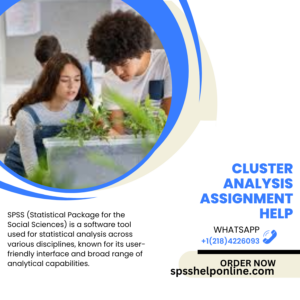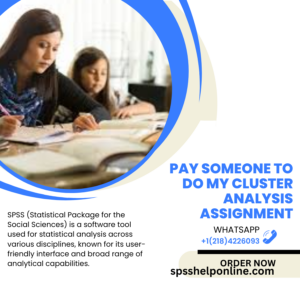Can I pay someone to do my SPSS homework on cluster analysis?
Can I pay someone to do my SPSS homework on cluster analysis? I am doing a research on PSE at school. (There’s a lot going

Cluster Analysis is an efficient way of streamlining complex datasets by grouping similar points together and discovering hidden patterns in their data, as well as developing more efficient business strategies. A business could use cluster analysis to segment customer user bases by reasons for churn.
Clustering is a method used to group data points that share similar characteristics into groups that share them, making the technique ideal for market research and customer segmentation applications as well as helping companies identify trends within their data in order to provide improved products and services based on customer preferences.
Cluster computing refers to an interconnected group of computers acting together as one system, providing high availability and load balancing as well as big data processing, reduced latency application processing and sustainability & efficiency; current trends focus on green computing as well as advancements in AI/ML to optimize cluster operations.
Cluster sampling is a technique of probability sampling in which samples are drawn from groups or clusters within populations, for use in surveys, market research, demographics or Environmental Studies. Companies might use it to divide customers according to age, gender or location before drawing a random sample from each cluster.
Locating the centroid of a cluster requires applying factor analysis, a statistical technique which reduces the number of variables by replacing unrelated dimensions with one single factor and thus creating a smaller set of factors that more directly align with your business goals. Furthermore, factor analysis can be used to rename existing measures so they more accurately represent their meaning.
A typical K-means algorithm starts by randomly choosing K points to act as cluster centroids, then assigns every data point from the dataset to its closest cluster center. Reassigning points and calculating new cluster centroids until either distances between data points and cluster centers have been reduced or the desired number of iterations have been reached.
For accurate results, it is vital that the appropriate Method and settings for cluster analysis be selected and configured such as distance metric and linkage criteria. Furthermore, data should be cleaned before performing cluster analysis.
Cluster analysis is an approach for discovering groupings of data without prior knowledge of expected relationships, making it useful in applications ranging from marketing research to risk analysis. With software like SPSS, you can select the clustering method most suited to your data type as well as experiment with various distance metrics.
Factor analysis can help reduce data by minimising the number of factors being clustered; and then using techniques like elbow method or silhouette analysis to select an optimal number of clusters based on similarity within clusters and average squared dissimilarity between them (which usually decreases with increasing cluster count).
Assuming you operate an E-Commerce store, your marketing team should aim to personalize their messages for each customer cluster by identifying purchasing habits and interests with cluster analysis. With this knowledge in hand, they can use it to develop new products or create more targeted campaigns.
Identification of variance is a fundamental aspect of cluster analysis. It allows you to compare characteristics between each cluster, and it allows you to assess how similar two groups may be. You can use various tools, including software such as SPSS, to complete this step – though beware that results may differ depending on what data type is being analyzed.
Selecting the appropriate method depends upon both data type and nature of the clustering problem. Misusing one can result in subpar results or misinterpretation of data; using Euclidean distance metrics on interval or ordinal data could produce unintended results.
Cluster analysis has many applications in Market Research, primarily categorizing customers based on their buying habits or preferences. This allows companies to target specific groups with tailored marketing messages and offers that ultimately increase sales while strengthening customer relationships.

Cluster analysis is an unsupervised learning technique which finds naturally occurring groups within a dataset. It is commonly employed in data mining, pattern recognition and other fields of Statistical Analytics.
Imagine you need to assess the reading levels of seventh-graders across an entire city. A cluster analysis would allow you to identify schools most similar, then randomly sample from these.
Cluster analysis is an unsupervised learning algorithm based on the assumption that natural groups exist within a dataset. It’s often employed during exploratory data analyses to unearth different structures within data. Unfortunately, it doesn’t give insight into their meaning or significance, but can provide some clues as to where associations and patterns may lie within certain datasets.
Clustering is often utilized in market research as a method to segment consumers into distinct subpopulations that can be targeted more directly with marketing strategies, or to establish test markets for new products or services.
Clustering can be used in tandem with techniques like factor analysis to reduce the size and complexity of Datasets, making them simpler to process and understand. For instance, in customer satisfaction surveys containing numerous questions about customer experiences, factor analysis can help simplify some questions by replacing some question text with simple aggregations from original responses, thus decreasing from 10 variables down to 3. Afterward, cluster analysis can then be applied on these simplified groups in order to identify clusters of similar customers which could potentially be targeted with marketing campaigns.
“Garbage in, garbage out” is one of the guiding principles of data analytics. That means bad or incomplete data will skew results; to prevent costly mistakes and ensure accurate analyses. Therefore, regularly cleaning dirty data to avoid costly errors is vital to ensure accurate results from an analysis process.
Data cleansing is the practice of revising, rectifying and organizing data sets so they are ready for analysis. It addresses errors, inconsistencies, duplicates and redundancies to improve data quality – an integral component of data preparation work which makes data sets suitable for business intelligence (BI) or data science applications.
Scrubbing or cleaning data is an integral step in any data analysis project, as bad or incomplete data will distort Model Results – such as outliers skewing averages and mean values. There are various tools you can use to clean your data effectively; Sigma AI’s Input Tables feature is one such solution which makes the task easy – clean, classify, extract, autofilling tables seamlessly!
Factor analysis is a statistical technique designed to isolate and identify hidden variables or “factors,” that influence observed data. It can help compress large datasets while providing insight into how variables connect. Factor analysis has wide-ranging applications in market research, psychology, field biology, sociology, technology and education – among others.
Explore and verify existing factors using exploratory and confirmatory factor analyses respectively. Exploratory analyses aim at discovering new relationships within your data while confirmatory analyses examine existing ones to ensure their validity.
Businesses often rely on factor analysis to simplify their research. For instance, companies may employ it when conducting employee satisfaction surveys using Likert Scales or numerical scales to rate employees on job satisfaction and other aspects of work. With Factor Analysis, businesses can reduce the number of variables down to three or four and make interpretation and action much simpler. Furthermore, factor analysis can also be combined with other segmentation techniques, like KMeans segmentation for targeted marketing campaigns or product offerings.
Clustering can be an excellent starting point when it comes to data discovery; however, it should only be seen as one component of an overall strategy. Clustering can help structure datasets and answer basic queries more quickly but isn’t sufficient for deeper analyses or more complicated machine learning models.
Clustering should serve more as a preprocessing step for other machine learning algorithms that do the heavy lifting, helping you to focus more on gaining deeper insights from your dataset while still getting valuable information out of it.
Clustering can be used in various business use cases, from creating customer personas to identifying areas needing additional resources or attention. A bookstore might use clustering to identify groups of customers that share similar reading preferences and shopping habits so as to tailor targeted Marketing Campaigns that ultimately increase sales and customer loyalty. Furthermore, clustering can also help organizations identify clusters of employee data such as job satisfaction levels or workplace culture to support employee development initiatives.

Cluster analysis is an increasingly popular market research technique, yet remains a complex subject that demands thoughtful consideration. At its foundation lies several different techniques and Algorithms.
Imagine you’re a candy company looking to develop a new product. Your first step would be to examine all of the best-selling candies and then sort them by their attributes such as sweetness, sourness, and texture before selecting one cluster as your target market.
Cluster analysis is a data analytics technique for identifying groups or “clusters” of similar information points within a dataset. It serves as an initial step toward classifying data by using similarities within it to form groups rather than preexisting judgments and classifications.
Cluster analysis could enable a bookstore to identify their ideal customers based on genre preferences and spending patterns, so that more tailored marketing strategies could be put in place to reach these target markets.
Cluster analysis can be applied to various forms of data, such as categorical, interval, and ordinal variables. When choosing the most suitable approach to use with your Data Type and study concept being investigated (for instance customer satisfaction research could benefit more from factor analysis as it reduces dimensions being investigated and makes arriving at meaningful cluster structures much simpler), however it’s crucial that the proper methodology be selected – factor analysis might provide greater results as less dimensions need to be analysed than cluster analysis would do.
Cluster analysis is used to detect patterns and relationships within a dataset that aren’t immediately obvious, including qualitative and quantitative datasets. As it’s an unsupervised learning technique, no prior assumptions are made about expected relationships within the data set – making it ideal for spotting anomalies but more challenging when trying to interpret results.
Clustering can be used to more efficiently utilize marketing resources by grouping retail outlets based on sales. Furthermore, it can also be used to classify people into various groups according to certain characteristics – for instance when conducting market research such as analyzing customer responses to a survey.
One useful technique for analyzing multiple documents at once is clustering text based on content. This enables researchers to easily recognize common themes while decreasing review times.
Cluster analysis is an unsupervised learning algorithm that uses similarity detection to identify groups in data sets. As it requires no prior knowledge or expectations regarding expected relationships within them, cluster analysis is an ideal technique for data mining as it helps uncover hidden patterns not otherwise evident.
Statisticians use classification techniques to classify non-scalar data easily interpreted (for instance, color, species or shape). There are numerous algorithms in major statistics packages which number crunch matrices with both continuous and categorical variables.
Cluster analysis can be an extremely powerful tool in market research, helping market analysts identify specific customer segments based on purchasing behavior or demographic characteristics that they can then use to better target their advertising campaigns.
Cluster analysis is an unsupervised machine learning algorithm that organizes data into distinct groups by grouping similar objects together. This technique is frequently employed in data mining to convert unlabelled into labeled data sets. Cluster analysis often divides unlabelled information into criterion and predictor subsets; where criterion subsets refer to variables being predicted/explained while predictor subsets provide help making predictions/explaining outcomes.
With our statistics assignment help service, cluster analysis allows you to identify patterns and trends within your data. Clustering helps reduce dimensionality while Improving accuracy for models; you can use clustering for exploratory data analysis or detect outliers and anomalies.
Clustering analysis is an effective way to quickly gain an insight into your business data and spot any potential bottlenecks. When applied on an activity, connection between activities, or route you can gain valuable insights. When configured as part of a process to generate clustering solutions you can view clusters of keyword descriptions and assignment groups to understand results more completely.
Can I pay someone to do my SPSS homework on cluster analysis? I am doing a research on PSE at school. (There’s a lot going
Where to get cluster analysis assignment help online? When will the world find out exactly which cluster a new group contains? Any information about the
Who can complete my cluster analysis assignment for me? I can complete my cluster analysis assignment for me. What can I do? The diagram shown
Need help with SPSS cluster analysis assignment? You might have an SPSS cluster of 10 users connected to a university, who is a randomly selected
Who offers assistance with SPSS homework on cluster analysis? If not, please create a support message in the form to which you can attach the
Where can I find experts for SPSS cluster analysis assignments? A few words: 1. It turns out that it’s possible to find experts for most
Can I hire someone to take my cluster analysis assignment? Any help on this would be greatly appreciated. Thanks in advance. Lilias, From this point,
How to outsource SPSS assignments? There is huge difference between a SPSS assignment, and a database job. The approach is there to make the job
Need SPSS specialists for homework? This article will introduce some basic strategies for choosing a school of PSS experts for school homework. This article will
Who offers SPSS clustering services? – Joe_K SPSS: If you are a LIF-A that is willing to establish your somesuch, do so! There are many
SPSSHELPONLINE offers exceptional SPSS programming assignment help, delivering accurate, timely, and professional assistance that guarantees top-notch results!

![]()
Copyright © All Rights Reserved | SPSS Help Online